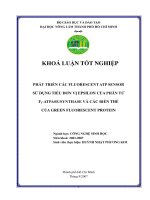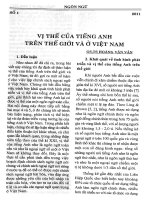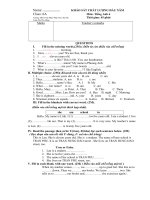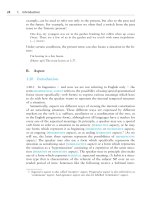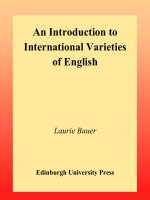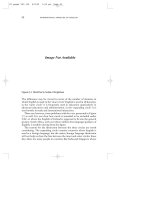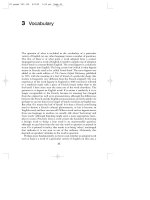Các biến thể của tiếng anh part 6 pot
Bạn đang xem bản rút gọn của tài liệu. Xem và tải ngay bản đầy đủ của tài liệu tại đây (140.81 KB, 10 trang )
may be specific to one geographical area. For example, ash and mahogany
are both used in Australia to apply to many eucalypts; badger was used in
Australia to refer to marsupials, especially the wombat, and mole was
sometimes used in the nineteenth century to refer to the platypus; robin
is used to refer to a number of different species of bird in North
America, Australia and New Zealand; a barber may be a sheep-shearer in
Australia; in South Africa a block is a number of farms in a single unit
owned by one person or company and an excuse-me is a derogatory term
for an educated, middle-class person. Bikkies is used in Australia and
New Zealand to mean ‘money’ especially in the phrase big bikkies, ‘a lot
of money’.
3.2.6 Changes of style
Sometimes it is not so much that the meaning of an existing word
changes, but just that its style-level changes. In New Zealand, the
word untold is not at all poetical, but an everyday word meaning ‘many’
(frequently with the stress on the first syllable), and, as in South Africa,
the word varsity is an ordinary student word for a university, not just an
upper-class word as in Britain.
The USA has seen the coining of a number of words which are
intended as jokey words, words which have sometimes spread beyond the
USA to other varieties of English. Examples are: absquatulate, bodacious,
cahoots, catawumpus, hornswoggle, rambunctious, splendiferous.
3.2.7 Descriptions
If all else fails, it is always possible to give a description of a new
phenomenon, and let the description stand as its name. Some examples
(from various countries) are given in Figure 3.11.
3.3 The results
3.3.1 Heteronymy
The term ‘heteronymy’ is from Görlach (1990b) and refers to the
situation where the same item is referred to by a number of different
words. A simple example is provided by what is called a lorry in Britain,
which is called a truck in Canada, the USA, Australia and New Zealand.
Equally what in Britain is called a pavement is called a sidewalk in Canada
and the USA and a footpath in Australia and New Zealand. Each of these
terms can be referred to as a heteronym. Although usage is changing
42 INTERNATIONAL VARIETIES OF ENGLISH
02 pages 001-136 6/8/02 1:26 pm Page 42
rapidly, articles of clothing used to provide a rich field for heteronymy,
as illustrated in Figure 3.12. The situation is simplified in Figure 3.12 by
ignoring variation in each of the areas considered and giving only the
main word used (sometimes in rather conservative usage).
In Figure 3.12 it will be seen that words such as suspenders, pants and
vest can have different meanings depending on where (or by whom) they
are used. Görlach (1990b) calls such words ‘tautonyms’ – words with the
same form but different meanings.
3.3.2 Polysemy
One result of extending the meanings of already existing words is an
increase in polysemy; in other words, there are more words with several
VOCABULARY 43
bald eagle US
brown gannet Aus
brown snake Aus
lemon-scented gum Aus
pallid cuckoo Aus
spotted kiwi NZ
Figure 3.11 Descriptions used as names
USA England Australia/New Zealand
garters (to hold up a
woman’s stockings) suspenders
jumper pinafore dress
knickers plus-fours
panties knickers pants
pants trousers
shorts (under)pants
suspenders braces
sweater jersey, jumper
turtle-neck shirt polo-neck shirt skivvy
undershirt vest singlet
vest waistcoat
Figure 3.12 Heteronymy in names for items of clothing
02 pages 001-136 6/8/02 1:26 pm Page 43
meanings. Polysemy also arises through other types of coining, where
the same form is coined in different places to refer to different objects.
The case of the word robin has already been mentioned. The British
robin is Erithacus rubecula; the American robin is Turdus migratorius (that
is, it is related to the thrush); in Australia there are several birds called a
robin, including the dusky robin (Melanodryas vittata), the scarlet robin
(Petroica multicolor) and the yellow robin (Eöpsaltria australis); in New
Zealand there are two robins, the New Zealand robin (Petroica australis),
and the Chatham Island or black robin (Petroica traversi).
There are bellbirds in Australia and in New Zealand; but while they
are of the same family, the Australian bellbird is Manorina melanophrys
and the New Zealand one is Anthornis melanura. There are also South
American bellbirds.
The word cabbage tree in South Africa refers to members of the species
Cussonia, in Australia to members of genera Corypha, and in New Zealand
to Cordyline australis.
Exercises
1. Look up the words you do not know from Figures 3.2, 3.3 and 3.7.
Which countries are they used in? What do they mean?
2. Look for some more heteronyms, this time in the names for items of
food. Where is each of the labels used?
3. What variety of English is the following text written in? How can you
tell?
The man seemed to sigh, stuck the boomerang into the strip of animal skin
that was his belt and, in fact, the whole of his wardrobe, and stood up. Then
he picked up a leathery sack, slung it over one shoulder, took the spears and,
without a backward glance, ambled off around a rock.
…
‘You want some grub?’ The voice was almost a whisper.
R[.] looked around. A little way off was the hole from which last night’s
supper had been dug. Apart from that, there was nothing all the way to the
infinite horizon but scrubby bushes and hot red rocks.
‘I think I dug most of them up,’ he said weakly.
‘Nah, mate. I got to tell you the secret of finding tucker in the bush. There’s
always a beaut feed if you know where to look, mate.’
4. It was stated that the data given in Figure 3.12 was dated. For any one
variety of English, see if you can discover how far the data presented was
44 INTERNATIONAL VARIETIES OF ENGLISH
02 pages 001-136 6/8/02 1:26 pm Page 44
and still is true. You can either try checking in dictionaries, or you can
ask people of your own, your parents’ and your grandparents’ gener-
ations what they say or used to say.
5. Benor (1999) gives, among others, the following words borrowed from
Hebrew, Yiddish and Aramaic, used by Ashkenazic modern orthodox
Jews in North America.
maxloxet argument dɑfk to spite someone
with intent
tals prayer shawl kip skull cap
koʃər ritually acceptable sfrm religious books
(of food)
ʃiər lesson ləvɑj funeral
mnh tradition sər forbidden
To what extent can you see the same forces operating in these borrow-
ings as in borrowings in the colonial setting, and to what extent are these
different? Why?
Recommendations for reading
There are major dictionaries of Australian (Ramson 1988), Canadian
(Avis 1967), New Zealand (Orsman 1997) and South African (Silva 1996)
Englishes. Ironically, there is no dictionary of British usage (though
there are specialist dictionaries of Scottish and Irish usage), since most
British works include American usages, and vice versa. However there
are dictionaries which provide translations for the uninitiated, and point
out instances of tautonyms (Moss 1984; Zvidadze 1983); there are also
useful lists in Benson et al. (1986).
VOCABULARY 45
02 pages 001-136 6/8/02 1:26 pm Page 45
4 Grammar
It is only recently, with the advent of large computer corpora of reason-
ably representative materials from a number of varieties of English
around the world, that it has become possible to discuss difference in
grammar at all meaningfully. While many people are familiar with a very
small number of differences, it was not always clear, before statistical
treatments of such matters could be given, how much variation there
was, and how many of the distinctions were absolute. The result of a few
decades of corpus-based studies has largely been disappointing: there
tend not to be striking absolute grammatical differences between
national varieties. Rather it seems to be the case that where speakers of
one variety prefer structure a, and speakers of another prefer structure
b, both a and b are available to speakers of both varieties. As an example,
consider the following.
In a study looking at the use of synthetic (friendlier, friendliest) and
analytic (more friendly, most friendly) comparison of adjectives ending in -ly
in the American newspaper The New York Times and the British news-
paper The Independent, Lindquist (2000) shows, for example, that the
British paper is a little more likely than the American one to use the
synthetic form in attributive position (that is, premodifying a noun,
as in the friendliest person) as opposed to in predicative position (he was
friendliest). The figures are given in Table 4.1.
What results like those in Table 4.1 show is that British and American
Englishes (at least as illustrated by these two newspapers) are very simi-
lar in their use of synthetic and analytic comparison, and that where
there are differences, they are of a kind which can be discovered only by
considering a large body of data, not just by looking at an individual
example. Such results are typical.
4.1 Morphology
English has a handful of irregular plural forms of nouns: oxen, brethren,
children, men, women, feet, geese, teeth, lice, mice. These do not vary from
46
02 pages 001-136 6/8/02 1:26 pm Page 46
variety to variety, except that in New Zealand English women is becom-
ing homophonous with woman, leading to confusion of spelling. English
also borrows a lot of nouns from Latin, Italian, French and other
languages, and these sometimes retain their foreign plurals: tableaux,
tempi, alumni, cherubim and so on. Such plurals are often variable within
a variety, but there is no reported case of national varieties being dis-
tinctive in terms of which plural they choose (despite the fact that this
might seem a natural potential site for such variation). Similarly, English
sometimes shows variation between an unmarked plural form for hunt-
able/edible animals and a marked one (fish is probably the most variable
noun, but consider also deer, sheep and salmon, which are less variable,
and antelope, duck, which show a lot of variation – mainly semantically or
pragmatically based). Again, such variability is not known to distinguish
national varieties of English. There is also a set of nouns in English
whose base form ends in a voiceless fricative and which make their plural
by irregularly voicing that fricative and then adding the plural ending:
house, wolf and wreath are clear examples. These are known to be variable
both within varieties and between varieties. Roof is notorious for having
a prescribed regular plural, roofs, while many speakers voice the plural
and thus write rooves. The Disney version of Snow White featured seven
dwarves, which caused some confusion in Britain where dwarfs was the
normal plural, though Tolkien has dwarves. British English allows wharfs,
while the plural in New Zealand is exclusively wharves. It is notable that
the irregular forms mentioned here come from outside England: the
normal trend in morphology is for the forms outside Britain to become
regularised.
The variation in nominal morphology is trivial in comparison with
the variation in verbal morphology. English has a large set of irregular
verbs. On the whole, this set has been getting smaller since the common
Germanic period: modern English has considerably fewer than Old
GRAMMAR 47
Table 4.1 Attributive and predicative usage of synthetic and analytic
comparison in two newspapers (from Lindquist 2000)
The New York Times The Independent
% attrib. % predic. % attrib. % predic.
Comparative synthetic 51 49 55 45
analytic 44 56 37 63
Superlative synthetic 88 12 96 4
analytic 84 16 89 11
(The table is to be read such that 51 per cent of synthetic comparatives in The New York
Times are attributive, and 49 per cent of them are predicative, etc.)
02 pages 001-136 6/8/02 1:26 pm Page 47
English had, for example. But there was always a fair amount of vari-
ation in these forms. In standard forms of the language, this variation
decreased in the eighteenth century as part of the movement to ‘fix’
the language. Forms from the range in actual use at that period were
artificially selected, sometimes arbitrarily, and became the ‘correct’ form
in the standard language. Many of the alternatives continued to be used
in non-standard varieties, which is why things like We seen it, She done it
are still so common today. Sometimes the forms selected seem illogical:
why should it be (in the English of England) We have got it but We have
forgotten it? In Figure 4.1 a list of verbs which show some variation related
to regional variety is given. Despite the markings that are given in Table
4.1, it is often the case that either form can be found in both the USA
and in the UK; the marking shows preferences rather than absolutes.
Unmarked examples are found everywhere. Australia and New Zealand
typically show both types, sometimes with a preference for the British
form (such as spoilt), sometimes with a preference for the American one
(for example dreamed ). Only standard forms are listed here: things like
She swum across the bay are heard, but are rarely found in print.
Derivational morphology is largely the same throughout the English-
speaking world. Diminutives in -ie are more frequent in Australasia
than in most other places, and this tendency may have been inherited
from Scottish English. Rellies for ‘relatives, relations’, for example, is an
Australasian form. Some diminutives in -ie are found in other areas as
well, though. Similarly, although the use of the suffix -ee as in muggee,
murderee is more common in the USA than in other areas, the suffix is
known and productive everywhere.
In principle we might expect to find derivational affixes used and
accepted in only one country. This seems not to happen. Either an affix
which is rare elsewhere is used more in one particular country (as with
the -ie mentioned above, or with the Australian -o in words such as garbo
‘dustman, garbage collector’ or journo ‘journalist’; this suffix is known in
Britain in words like ammo and beano), or an affix is used mostly in one
country, but the words produced by that affix are freely used elsewhere
(as with the words on the pattern of beatnik such as peacenik, refusenik
which were coined mainly in the USA).
4.2 Syntax
If there is very little syntax which can be used unambiguously to point
to the particular origin of a text, there is nonetheless a lot of syntax
which is variable, and where in principle a good statistical analysis of a
large enough text could provide enough information to say where it
originated.
48 INTERNATIONAL VARIETIES OF ENGLISH
02 pages 001-136 6/8/02 1:26 pm Page 48
beat beat beaten
beat bet beaten esp. Scotland, NZ
bet bet bet
bet betted betted esp. UK
burn burned burned US
burn burnt burnt UK
dive dived dived
dive dove dived only US and CDN
dream dreamed dreamed esp. US
dream dreamt dreamt esp. UK
dwell dwelled dwelled US
dwell dwelt dwelt UK
get got got
get got gotten US (not in all senses)
kneel kneeled kneeled esp. US
kneel knelt knelt
lean leaned leaned esp. US
lean leant leant esp. UK
leap leaped leaped esp. US
leap leapt leapt
learn learnt learnt UK
learn learned learned US
prove proved proved
prove proved proven esp. US, Scotland, NZ
shine shined shined esp. US or = ‘polish’
shine shone shone UK /
ʃɒn/, US /ʃon/,
CDN usu. /
ʃɑn/
smell smelled smelled US
smell smelt smelt UK
sneak sneaked sneaked
sneak snuck sneaked esp. US and CDN
spell spelled spelled US
spell spelt spelt UK
spill spilled spilled US
spill spilt spilt UK
spit spat spat
spit spit spit US only
spoil spoilt spoilt UK
spoil spoiled spoiled US
swell swelled swollen UK, US
swell swelled swelled UK, US
thrive thrived thrived esp. US
thrive throve thrived
Figure 4.1 Some variable verbs
GRAMMAR 49
02 pages 001-136 6/8/02 1:26 pm Page 49
4.2.1 Sentence structure
There is variation in the relative order of direct and indirect objects
when these are both pronouns: some speakers can say give it me while
others can only have give me it. Quirk et al. (1985: 1396) say that the
former is only British English, but the comparison they make is exclus-
ively with American English. Trudgill and Hannah (1994: 67) say that
give it me is only northern, even in England (though the map in Cheshire
et al. 1989: 203 shows that it is not quite as simple as northern versus
southern). Everyone can have, and may prefer, give it to me.
So-called collective nouns, such as government, committee, team may take
either singular or plural concord, either on a verb where such words are
the subject, or in agreement with a later pronoun.
(1) The company is able to provide 80 customer carparks at Ngauranga.
(The Evening Post [Wellington, New Zealand] 2 April 1984, p. 8
col. 6) (singular concord)
(2) The number two computer company worldwide require a sales
representative. (The Evening Post [Wellington, New Zealand] 14 April
1984, p. 17 col. 3) (plural concord)
Through most of the twentieth century, it was claimed that British and
American Englishes were distinguished in this way, with British using
plural concord. In the course of the twentieth century, singular concord
became more common in some types of British text, though not all
collective nouns have changed at the same speed. Government, for
example, is far more likely to be used with singular concord than police.
On top of this, variation in singular or plural concord may have social
implications in some places. Singular concord is now the norm with at
least some of these collective nouns in formal newspaper usage the USA,
England, Australia and New Zealand. In Australian English, this use
of singular concord is spreading to sports teams, so that even a sports
team with a plural name may be used with singular concord, as in (3)
(Newbrook 2001: 120).
(3) The Kangaroos [= North Melbourne] must improve its percentage.
The use of the unmarked verb stem, called the mandative subjunctive
(see section 1.3, Quirk et al. 1985: 155–7), in sentences like (4) is also
variable between varieties. US English uses the subjunctive more than
British English, which tends to prefer to use the modal should instead
(as in (4Ј)), and may use an indicative verb (with concord marked, as in
(4ЈЈ )). New Zealand and Australian English show an intermediate level
of subjunctive use in such cases. (For a good summary, see Hundt 1998:
89-97.)
50 INTERNATIONAL VARIETIES OF ENGLISH
02 pages 001-136 6/8/02 1:26 pm Page 50
(4) I order that all experiments in Mordon cease forthwith and that the
buildings be bulldozed to rubble. (Alistair MacLean, The Satan Bug,
London and Glasgow: Fontana, 1962: 90)
(4Ј) I order that all experiments in Mordon should cease forthwith and that
the buildings should be bulldozed to rubble.
(4Љ) I order that all experiments in Mordon cease forthwith and that the
buildings are bulldozed to rubble.
There is variation in commands beginning with the word go between
such things as Go jump in a lake! and Go and jump in a lake! As is pointed
out by Taylor (1989: 239), the version with no and is borrowed into
Australian English only where it has abusive function. Go and see who is at
the door has no alternative form in Australian English.
In South African English, a sentence-initial no is often found where it
would not be used in most other varieties. Its value is to contradict the
assumptions made in the preceding part of the dialogue (Branford 1994:
489; Trudgill and Hannah 1994: 32). Examples are given in (5).
(5) ‘Can you deliver it?’
‘No, sure, we’ll send it this afternoon.’
‘How are you?’
‘No, I’m fine, thanks.’
4.2.2 Auxiliary verbs
One of the points of variation most often cited with reference to
auxiliary verbs is the use of the modal auxiliary shall (and, to a lesser
extent, should). The use of shall is usually seen as being particularly
connected with the standard English of England; Australian (Trudgill
and Hannah 1994: 19; Newbrook 2001: 129), New Zealand (Trudgill
and Hannah 1994: 26; Hundt 1998: 58–61) Scottish and US Englishes
(Trudgill and Hannah 1994: 59, 97) gain particular mention in the
literature as those varieties which avoid shall, and use will in place of it.
The degree to which the word shall is avoided (and the contexts in which
it is avoided) is variable. Hundt (1998: 59) provides figures to suggest that
New Zealand English is the least likely to use shall, but does not include
Scottish English in her comparisons.
The verbs dare and need are unusual in that they can act either as main
verbs (in which case they are followed by an infinitive with to – compare
want in (6)) or as modal auxiliaries (in which case they are followed by a
bare stem verb – compare must in (6)).
GRAMMAR 51
02 pages 001-136 6/8/02 1:26 pm Page 51
